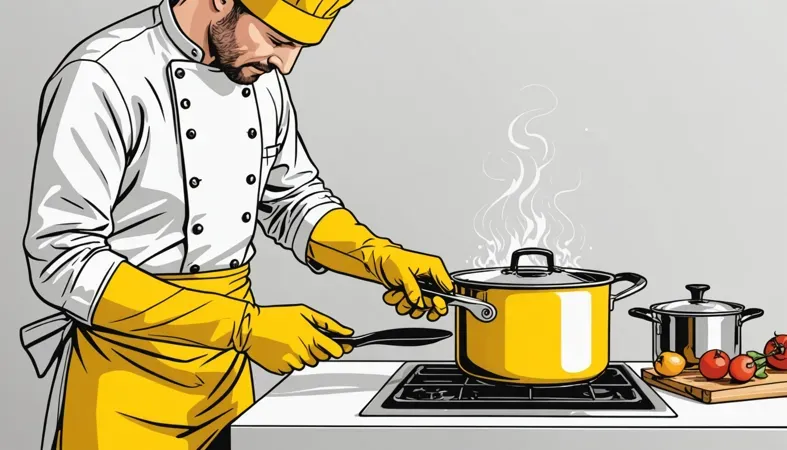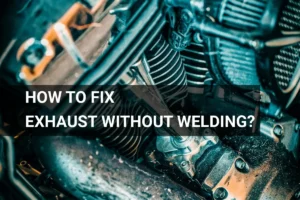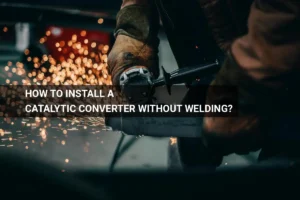Can You Use a Welding Blanket on a Smoker? Safety, Benefits, and Tips
Published on: May 29, 2025 | Last modified: March 4, 2025
By: Tyler James
A welding blanket is a protective cover made from fire-resistant materials. It’s commonly used to shield surfaces from sparks and heat during welding processes.
It’s a question I’ve heard often: can you use a welding blanket on a smoker? This topic’s crucial because the right blanket can prevent sparks from causing fires and protect your smoker. I’ve seen firsthand how essential it is to use proper materials for safety and performance.
In this article, you’ll explore what a welding blanket is, the different types available, necessary steps for use, precautions to take, common problems to watch out for, and how to care for the blanket. You’ll learn what these blankets are made of, their uses, and alternative options to achieve similar results. Plus, we’ll cover advantages and applications across various fields.
Contents
- Can You Use a Welding Blanket on a Smoker?
- What is a Welding Blanket?
- Types Of Welding Blankets
- Prerequisites
- Steps to Use a Welding Blanket on a Smoker
- Precautions
- Types Of Welding Blanket Uses
- Factors Influencing the Use Of Welding Blankets
- Typical Problems to Be Aware Of
- Aftercare, Inspection, and Advanced Tips for Using a Welding Blanket on a Smoker
- Advantages Of Using a Welding Blanket on a Smoker
- Applications Across Different Fields
- Alternative Heat Retention Solutions for Smokers
- Other Options for Achieving Similar Results As Using A Welding Blanket on A Smoker
- Frequently Asked Questions (FAQs)
- Conclusion
- Additional Reading
Can You Use a Welding Blanket on a Smoker?
Yes, you can use a welding blanket on a smoker. It’s fairly easy, but ensure it’s rated for high temperatures (At Least 1,000°F or 538°C). Wrap your blanket securely around the smoker for even heat distribution and to protect from wind.
What is a Welding Blanket?
A welding blanket is a protective cover made from durable, heat-resistant materials. It’s typically made of fiberglass, withstanding temperatures up to 1,000°F (538°C). These blankets prevent sparks and heat from igniting flammable materials nearby. With a standard size of about 6×8 feet (1.8×2.4 M), they’re essential in welding environments and construction sites.
When it comes to using a welding blanket on a smoker, it’s worth exploring. I’ve seen people use similar materials for heat protection while smoking meat. However, consider the specific properties of the blanket before proceeding.
I once used a welding blanket to shield my outdoor cooking setup from the wind during a chilly evening smoke session. While it worked well, understanding the material is crucial; some are designed for welding, while others are better for high-heat cooking. If you’re wondering how to use a welding blanket on a smoker, always verify the fabric type and temperature rating. Safety should be your top priority!
Types Of Welding Blankets
What types of welding blankets can you consider?
-
Fiberglass Welding Blankets
Fiberglass blankets are durable and heat-resistant, typically rated for high temperatures. You can use a fiberglass welding blanket on a smoker. Make sure it’s positioned properly to avoid contact with flames or heating elements, and secure it well to prevent accidental slips during cooking.
-
Silicone-coated Welding Blankets
These blankets provide excellent heat resistance and an added layer of silicone protection. You can use a silicone-coated blanket on your smoker by draping it across areas that might catch sparks or splatter, ensuring it doesn’t significantly restrict airflow around the cooking zone.
-
Wool Welding Blankets
Wool blankets offer natural fire resistance but may not retain heat as effectively. While they aren’t the best choice for a smoker, they can be used if kept a safe distance from the flames to enhance safety around your smoker.
-
Fire-resistant Welding Blankets
These specially treated blankets resist ignition and are ideal for shielding against flames. You can safely place a fire-resistant welding blanket near your smoker. When using it, shield the sides of the smoker while ensuring it’s stable, allowing good airflow without blocking heat.
-
Canvas Welding Blankets
Canvas blankets have lower heat resistance and primarily protect against spatter. It’s not recommended to use a canvas blanket directly on a smoker due to fire risk. To ensure safety, use it away from heat zones, such as draping it around larger structures of the grill.
That covers the various types of welding blankets. Let’s now take a look at the necessary prerequisites.

Prerequisites
What do you need before starting?
- Welding Blanket: You need a welding blanket, like the Harbor Freight Welding Blanket or a Carbon Felt Welding Blanket. It’s essential for protecting your smoker from heat and sparks.
- Fire-Resistant Blanket: Consider a Fiberglass Welding Blanket for added heat resistance. It can handle high temperatures up to 1,000°F (537°C), making it ideal for smoke protection.
- Welding Blanket Material: Choose materials specifically designed for welding, such as fiberglass or silicone-coated options. These materials protect against fire hazards.
- Smoker Blanket: A specialized Smoker Blanket helps maintain a consistent temperature and protects the structure. It’s useful for long smoking sessions.
So far we covered the necessary requirements for using a welding blanket. Next, let’s look at how to properly use it on a smoker.
Steps to Use a Welding Blanket on a Smoker
Here are the steps to effectively use a welding blanket on your smoker.
-
Check the Smoker’s Surface Temperature
Before covering anything with a welding blanket, check the smoker’s surface temperature. It should not exceed 500°F (260°C). Higher temperatures can damage the blanket and cause fires. I learned the hard way—keep it cool first!
Use an infrared thermometer for accuracy. This handy tool measures the temperature without touching the smoker, avoiding burns while giving real-time heat data.
-
Wrap the Smoker With the Welding Blanket
Once you confirm the temperature is safe, wrap the blanket around the smoker. Cover all exposed areas without leaving gaps. This insulation helps retain heat during cooking. Ensure it’s secure but not too tight to avoid damaging the blanket.
Use clamps or weights to keep the blanket in place. If it’s windy or you’re cooking outdoors, securing the blanket prevents it from blowing away, preserving the warm cooking environment.
-
Monitor Cooking Progress
As your food cooks, monitor the temperature. If the smoker’s heat fluctuates too much, it affects cooking time. Adjust vents to maintain a consistent temperature. The ideal range for most meats is 225°F (107°C) to 350°F (177°C).
Use a probe thermometer for the meat as well. This way, you can check both the smoker’s temperature and food doneness. Adjusting the welding blanket can help stabilize the heat if necessary—a trick I swear by!
-
Remove the Welding Blanket Carefully
Once your food is done cooking, let the smoker cool down slightly, then carefully remove the blanket. Wear gloves, as the blanket may still be hot. I use tongs to peel it away without touching my skin!
Hang or lay the welding blanket out to cool completely. Check for any damage or wear to determine if you can reuse it. Proper cleaning extends the blanket’s life and saves you money in the long run. Understanding techniques to minimize weld spatter can improve your welding efficiency, which is covered in detail in this guide on avoiding spatter in welding.
We’ve wrapped up the steps for using a welding blanket on a smoker. Next up, we’ll look at precautions.
Precautions
Let’s review key safety tips for your welding blanket.
- Inspect Regularly: Always check your blanket for tears. I recommend the Steiner 313 Welding Blanket for its durability.
- Position Correctly: Keep your blanket close to the fire area without touching it! This minimizes fire risk and protects the surroundings.
- Secure in Place: Use weights to hold down the blanket. This prevents it from moving in windy conditions.
- Follow Recommendations: Use according to the manufacturer’s guidelines. Refer to ISU 863 and OSHA standards for protection specifics.
Knowing these safety precautions is vital for protecting yourself and your equipment.
That covers precautions for welding safety. Let’s now take a look at the various uses of welding blankets.
Types Of Welding Blanket Uses
Let’s explore the different uses of welding blankets, including fire protection, heat insulation for cooking, preventing heat loss, enhancing smoking efficiency, and shielding surrounding areas. Ensuring the proper setup of your welding gear is crucial, so it’s important to know how to adjust welding helmet settings for optimal safety and performance.
-
Protection From Fire Exposure
A welding blanket is vital for fire safety. Made from fire-resistant materials, it can withstand high temperatures, typically up to 1,000°F (538°C). Can you use a welding blanket on a smoker? Absolutely—it protects surfaces from sparks while cooking.
-
Heat Insulation for Cooking
Welding blankets provide excellent heat insulation. They help retain heat when grilling or smoking, making cooking more efficient. For example, when using a Traeger smoker, consistent heat significantly enhances flavor and cooking speed.
-
Preventing Heat Loss
These blankets effectively minimize heat loss. By wrapping your smoker, you can maintain desired temperatures while using less fuel. Studies show that reducing heat loss by just 10% can save you up to 20% in fuel costs.
-
Enhancing Smoking Efficiency
Using a welding blanket on a smoker boosts efficiency. It stabilizes internal temperature, ensuring meats stay juicy and flavorful. From my experience, wrapping my smoker added hours of consistent heat, transforming my BBQ into mouthwatering perfection.
-
Shielding Surrounding Areas
Welding blankets serve as protective barriers. They cover nearby surfaces to prevent potential fire hazards when welding or smoking. A safe workspace minimizes risks, especially in tight or cluttered areas.
Factors Influencing the Use Of Welding Blankets
What factors determine the effectiveness of a welding blanket with a smoker?
-
Material Durability
The welding blanket’s material is crucial. Most blankets are made of fiberglass or carbon felt, providing heat resistance up to about 1,000°F (538°C). Using lower-quality materials can lead to hazards.
-
Temperature Ratings
Each welding blanket has a specific temperature tolerance. Always check the rating before use; some can handle extreme heat while others may not. A blanket rated below 500°F (260°C) is too risky for high-heat smoking.
-
Size Of the Smoker
I’ve faced this issue—using a blanket that’s too small for your smoker. Ensure the blanket adequately covers the smoker to prevent heat loss and maintain safety by avoiding open flames in smaller areas.
-
Smoker Cooking Method
Your cooking method matters. For example, indirect grilling requires less heat efficiency than direct grilling. Assess your method to see if a welding blanket will aid in heat retention.
-
Environmental Conditions
Wind and cold can quickly lower your smoker’s temperature. In breezy or chilly conditions, using a blanket helps maintain heat. Consider the environment and select a blanket that suits your conditions.
Typical Problems to Be Aware Of
Let’s look at common issues related to the welding blanket.
-
Inadequate Heat Retention
The welding blanket may not retain heat effectively. Check if the material’s specifications meet the requirements; look for minimum temperature ratings. Using a higher-grade blanket can resolve this issue.
-
Overheating Of the Blanket
I’ve encountered this before: if the welding blanket overheats while shielding certain materials, it can degrade. Monitor temperatures with infrared thermometers; adjusting the distance to the heat source will help.
-
Exposure to Moisture
The welding blanket risks degrading if exposed to moisture. Inspect for signs of wetness or rust on metal components. Ensure it’s dry before use to maintain its integrity.
-
Risk Of Fire if Not Monitored
Using a welding blanket improperly can spark a fire. Keep a fire extinguisher handy and check temperatures regularly to mitigate potential risks.
-
Wear and Tear Over Time
With usage, the welding blanket shows wear and tear. Check for frayed edges or discolorations. Replace it if damage exceeds 5% of the total area to ensure safety.
Aftercare, Inspection, and Advanced Tips for Using a Welding Blanket on a Smoker
Here’s detailed advice on maintaining and inspecting your welding blanket after use on a smoker.
Aftercare Tips
After using a welding blanket on your smoker, wash it according to the manufacturer’s guidelines. Typically, I suggest hand-washing it in cold water (About 15°C or 60°F). Avoid bleach or fabric softeners, as they can deteriorate the fibers. Let it air dry completely before storing to prevent mildew.
Inspection Protocols
Inspect your welding blanket regularly for signs of wear or damage. Look for punctures larger than 1 cm (0.4 Inches) or frayed edges. Use a product like the Dewalt DCK278C2 to test the edges for weaknesses, ensuring the points remain safely contained. Understanding electrode classification can enhance your knowledge about its specific applications, and you can explore more about 316 stainless electrodes.
Expert Tips
Keep an eye on your welding blanket’s temperature tolerance. Always refer to the manufacturer’s heat rating, which is often 540°C (1000°F) for heavy-duty types. For advanced cooks, consider overlapping two blankets in tricky smoking conditions to create an extra barrier, especially when temperatures drop below 0°C (32°F).
Advantages Of Using a Welding Blanket on a Smoker
The main benefit of using a welding blanket on a smoker is heat retention. I once used one to maintain a steady temperature while smoking brisket, and it worked like a charm!
These blankets also provide excellent insulation, protect against wind, enhance safety by preventing sparks, and are easy to clean. Plus, they’re lightweight, making them portable for outdoor cooking. What more could you ask for?
Applications Across Different Fields
I’ve seen people use welding blankets to insulate smokers in cold weather, but they have many unique applications, such as:
- Fire Protection: Surrounding a smoker with a welding blanket shields it from sparks while grilling. This helps prevent fires, especially during outdoor cookouts.
- Heat Retention: A welding blanket traps heat, making it easier to maintain consistent temperatures in a smoker, which is vital for perfectly smoked meats.
- Wind Shielding: Placing a welding blanket around the smoker blocks cold winds, ensuring even cooking and flavor retention. Many pitmasters swear by this method.
- Equipment Cover: When not in use, a welding blanket protects your smoker from rain and debris, extending its lifespan. It’s common among avid barbecue lovers.

Alternative Heat Retention Solutions for Smokers
Besides welding blankets, you have other options to enhance heat retention when smoking.
| Option | Description | Temperature Resistance (°F / °C) | Best Use Case |
|---|---|---|---|
| Grill Blankets | Insulation designed especially for outdoor cooking. | Up to 600°F / 316°C | Ideal for long smoking sessions in cooler weather. |
| Carbon Felt Blankets | High heat-resistant material used across various industries. | Up to 1,800°F / 982°C | Perfect for high-heat applications or smoking at elevated temps. |
| Fiberglass Blankets | Commonly used in welding but also works for smoking. | Up to 1,000°F / 538°C | Great for protecting the smoker from heat loss and wind. |
| Insulated Smoker Covers | Fabric covers that retain heat and protect from the elements. | Varies by brand; typically around 400°F / 204°C | Useful for everyday protection and retaining heat. |
| Thermal Blankets | Made of specialized materials for heat retention. | Up to 1,000°F / 538°C | Best for insulating against extreme heat loss during long cooks. |
Each option has unique benefits, so consider your specific needs when choosing a heat-retention solution.
Other Options for Achieving Similar Results As Using A Welding Blanket on A Smoker
If you’re looking for alternatives to help maintain heat, consider using a dedicated grill blanket, like the Smoker Blanket. It’s specifically designed for smoking meat and provides insulation. In my own experience, a Carbon Felt Welding Blanket works wonders too; it’s heat-resistant and can protect surfaces from high temperatures.
Another option is a fiberglass welding blanket, which is well-suited for extreme heat. It’s available at places like Harbor Freight or Home Depot. I find that these materials not only serve a protective function but can also help improve overall cooking efficiency.
Frequently Asked Questions (FAQs)
Now let us look at some common questions. I typically get asked about welding blankets.
Can I Cut a Welding Blanket?
Yes, you can cut a welding blanket. Welding blankets are designed to withstand high temperatures, so cutting them won’t reduce their effectiveness significantly. Just make sure to seal the edges after cutting to prevent fraying, which can occur at temperatures around 400 °C (752 °F).
What Are Welding Blankets Made Of?
Welding blankets are typically made of fiberglass or Kevlar. These materials can handle high heat, up to 1,093 °C (2,000 °F) for fiberglass and 400 °C (752 °F) for Kevlar. Knowing the composition helps you pick the right blanket for your specific welding job. It’s crucial to be aware that dangerous fumes can be released when welding stainless steel.
What is a Welding Blanket Used for?
A welding blanket is used to protect nearby objects from sparks and heat. They’re essential for safety in welding environments, as they can prevent fire hazards and damage to equipment. Typically, they cover up to 3.6 square meters (39 Square Feet) area efficiently. When dealing with challenging situations like welding spatter affecting nearby surfaces, detailed strategies on fixing spatter on glass become invaluable for maintaining equipment integrity.
How Much Heat Can a Welding Blanket Withstand?
A welding blanket can withstand temperatures up to 1,093 °C (2,000 °F), depending on the material. This high heat resistance makes it perfect for welding and cutting tasks, helping to protect the surrounding area from intense heat and sparks.
What is the Difference Between a Fire Blanket and a Welding Blanket?
The difference between a fire blanket and a welding blanket lies in their intended use. A welding blanket is designed for high heat protection during welding, while a fire blanket is used mostly to smother small fires. Each serves a unique safety purpose in different scenarios.
Conclusion
I’m glad we could cover this together. We explored what welding blankets are, their various types, prerequisites, how to use a welding blanket on a smoker, and the precautions you need to take. We also discussed common issues, maintenance, benefits, and alternatives for achieving similar results.
So, can you use a welding blanket on a smoker? In simplest terms, yes, you can, provided you consider factors like heat resistance and material safety. Feel free to reach out if you have further questions about welding blankets, including what they’re made of or how to use them safely with different types of smokers.
For additional insights and related articles, we invite you to visit our homepage at What is Welding, where you can find more expert blogs and welding advice.
Additional Reading
- American Welding Society. (2020). AWS Welding Handbook: Welding Science and Technology (Vol. 1). Miami, FL: AWS.
- Appleton, W. (2020). Welding and Cutting: A Practical Handbook. Hauppauge, NY: Nova Science Publishers.
Tyler is a passionate DIY welder and self-taught metal artist with years of hands-on experience transforming raw materials into functional and artistic creations. Specializing in MIG welding, Tyler crafts everything from custom furniture to outdoor sculptures, blending creativity with technical skill. Committed to making welding accessible, Tyler shares practical insights and project inspiration to help beginners and hobbyists confidently explore the world of metalworking.
American Welding Society, BBQ Equipment, Cooking Tips, Fire Protection, Heat Retention, Safety Tips, Smoker Safety, Welding, Welding Blanket, Welding Gear, Welding Safety







